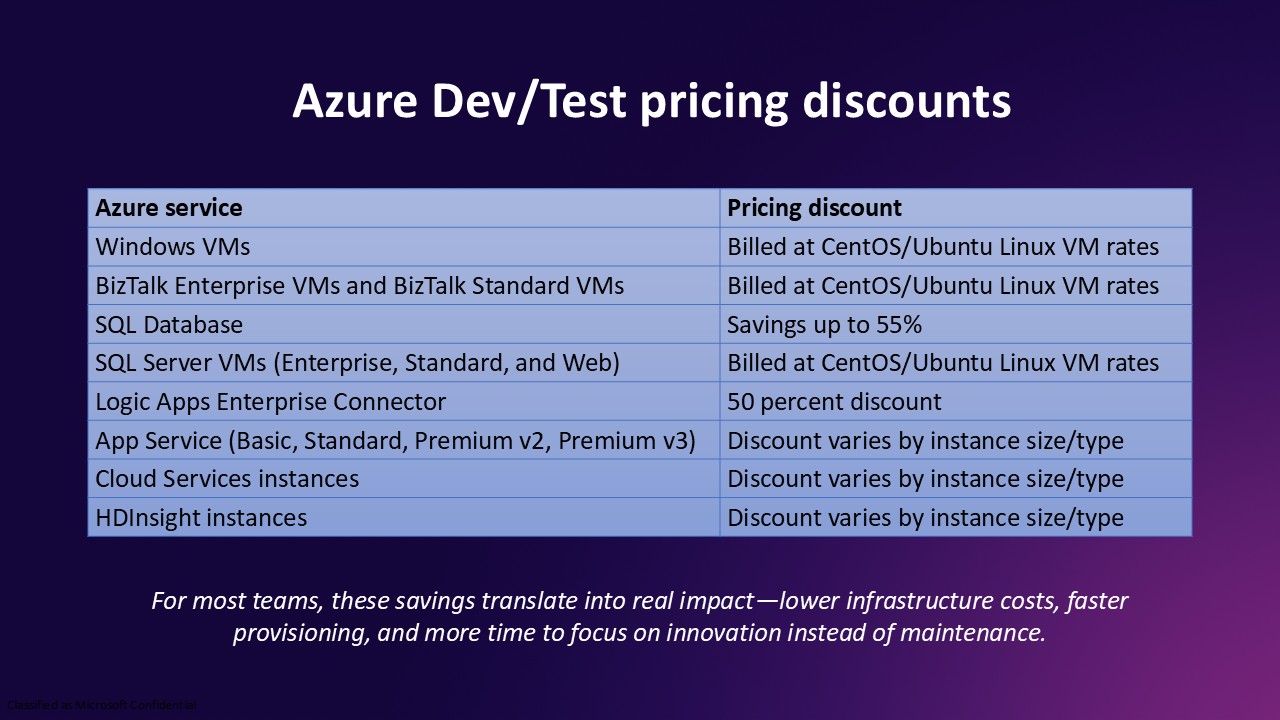Before joining Microsoft, I served as VP of Application Development at one of the largest temporary staffing companies in the United States. I’ll never forget the look on our CFO’s face when I told him we needed two to three additional cloud environments to support a large-scale modernization project. His expression went from curious to cautious as he started calculating what that might mean for compute, storage, and database costs.
“You want three more cloud environments? Do you have any idea what that’s going to cost us each month?”
He wasn’t wrong to ask. Expanding our cloud footprint could easily double our monthly spend. What he didn’t realize was that we already had a built-in advantage—a Visual Studio Subscription benefit that provides discounted Dev/Test rates for non-production workloads in Azure.
Why This Matters
Like many enterprises, we were expanding our cloud footprint to support a modernization effort that touched multiple systems across accounting, ticketing, and field operations. Running in parallel across so many integration streams required more than just production and staging. We needed additional cloud environments for accounting integration, API modernization, mobile development, and quality assurance — each one mirroring production as closely as possible.
The challenge wasn’t technical, it was financial. Every new environment meant more compute, more storage, and higher monthly costs. Our CFO was right to ask where that money would come from.
That’s when I discovered something already included in our Visual Studio Professional and Enterprise subscriptions — the Azure Dev/Test benefit.
This benefit allows Visual Studio subscribers to run Windows and SQL Server VMs in Azure at the same base rates as Linux VMs of equivalent size. The Microsoft licensing costs are waived for development and testing, so you only pay for compute while it’s running. It’s a simple change with major impact: production-level environments for non-production costs.
The Pilot That Changed Everything
With cautious approval, I launched a pilot to test the Dev/Test benefit in action. Within a week, our team replicated the entire production environment in Azure using discounted Dev/Test rates. There were no procurement delays, no licensing complexities, and no approval bottlenecks—just straightforward cloud provisioning with real cost transparency.
That one-week turnaround shattered our assumptions about how quickly we could scale and test new workloads in the cloud.
Why Developers Love Dev/Test
When I lead focus groups at Visual Studio Live! events, I often ask developers which subscription benefits stand out beyond the IDE itself. The Azure Dev/Test benefit consistently ranks near the top. Developers tell me the same two things every time:
- Prototyping freedom: they can spin up environments on demand to test ideas without waiting for budget approvals.
- Production-grade testing: they can validate integrations and updates in environments that mirror production, without the production-level price tag.
It’s one of the most valuable capabilities hidden in plain sight. Every Professional and Enterprise annual subscription includes access to these discounted Dev/Test rates for non-production workloads.
Scaling the Solution
Once we proved the model worked, we expanded quickly. Using the Visual Studio Dev/Test benefit, our cloud environment evolved from a handful of shared test spaces into a scalable system that supported every stream of work:
- Dedicated environments for each integration area
- Parallel development that removed team bottlenecks
- On-demand provisioning that could be started or stopped as needed
- Minimal oversight required from IT operations
Because the benefit handled the licensing automatically, our IT pros no longer had to manage or approve environment requests. They stayed focused on higher-value initiatives while developers created the test environments they needed in minutes.
The result was faster releases, greater agility, and significantly lower operational costs.
Hidden Advantages
Beyond the speed and savings, several additional benefits became clear:
- Parallel velocity: multiple teams could work independently without stepping on each other’s code.
- Risk-free innovation: the reduced cost of experimentation encouraged creative problem-solving.
- Realistic validation: production-like conditions made deployments smoother and more predictable.
- Operational simplicity: no hardware maintenance, no software installs, and fewer administrative blockers.
What started as a cost-saving pilot ended up transforming how we delivered software across the organization.
How You Can Get Started
Visual Studio subscribers can access Azure Dev/Test pricing through one of three paths:
- Enterprise Dev/Test: available to organizations with an Enterprise Agreement (EA). This option provides centralized billing and the broadest management capabilities for teams running multiple non-production environments.
- Pay-As-You-Go Dev/Test: ideal for individual developers or small teams with Visual Studio Professional or Enterprise subscriptions who are not covered under an Enterprise Agreement.
- Azure Plan for Dev/Test: designed for customers with Microsoft Customer Agreements (MCA), offering simplified modern billing and flexibility as organizations transition away from legacy agreements.
Each path unlocks the same Dev/Test discounts already included with your Visual Studio subscription, helping you run Windows and SQL Server workloads in Azure at significantly reduced rates for development and testing.
The Takeaway
Most IT leaders still think of Visual Studio subscriptions as just IDE licenses. In reality, the Azure Dev/Test benefit is one of the fastest ways to reduce cloud spend while accelerating development.
Several customers have told me this single benefit can easily justify the full cost of a Visual Studio subscription through cloud-computing savings alone.
The real question isn’t whether you can afford to modernize. The real question is whether you can afford not to take advantage of the benefits you already own.
👉 Sign in to my.visualstudio.com today to explore Azure Dev/Test pricing and see how it can accelerate your next project.




Hey, thats awesome JIMMY! I get a BIG shoutout for everything right??? MAybe a little this liitle thaaat. Maybe some privacy garauntees Jimmy, dont be two timin!
What’s the benefit if I’m using Linux for deployment anyways?